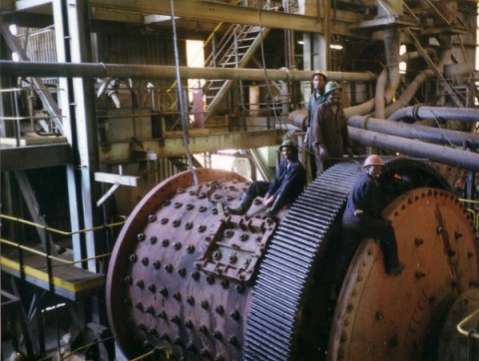Employment has nearly doubled, production has risen considerably and social investment has grown by leaps and bounds, while legacy problems such as the unrestrained emission of sulphur dioxide into the atmosphere are now being fully addressed.
The huge amount of capital investment being pumped into the continuous operation and expansion of the mines – which is over KR10 billion (US$2 billion) – on the other hand, clearly demonstrates that Mopani will remain part of Zambia’s mining sector for many years to come.
The company has recorded remarkable performance in a number of areas. Below is a review of a few selected areas to appreciate the place of the MCM in the mining sector and its contribution to the country’s economy.
EMPLOYMENT CREATION
The company’s current labour force stands at about 18,000 permanent and contractor employees, thereby making it one of the largest employers in Zambia besides Government.
Mopani inherited a workforce of just over 10,000 at inception. Within 12 years, the number has increased to today’s numbers, with a focus on sustainable and long term employment in the sector.
The labour force for the whole industry had slumped from the peak of 56,000 to just around 26,000 at privitisation in December 1999. This figure has now risen to around 50,000, excluding the small-scale mining sub-sector.
Ultimately, MCM accounts for 35 per cent of the total labour force in the mining sector. This excludes the number of people employed by suppliers whose existence largely depends on the company.
It is therefore against this background that Mopani is focusing on a number of initiatives, which will enhance growth and support local supplier companies, also ensuring that price and quality are competitive, as well as embarking on huge investment in training to build a dedicated and skilled local workforce.
This is essential to compete in the global industry and ensure efficiency and productivity improvements to benefit all stakeholders.
Mopani monitors closely the use of local suppliers and scrutinises not only volumes purchased within the Copperbelt and Zambia, but also the ownership structures of the companies that the firm uses.
MCM has a close working relationship with the various associations representing the suppliers, to ensure that the mining firm was making headway in promoting localisation. As a secondary strategy, the firm is assisting local suppliers to grow their business into the Democratic Republic of Congo (DRC) to its other large mining operations, whilst in some cases providing security to protect their investment.
CAPITAL INVESTMENT
Since inception in 2000, MCM has invested over US$ 2 billion in its mining operations.
Among the highly significant projects undertaken are the $323 million Synclinorium Shaft and the Smelter up-grade project. The Synclinorium Shaft will extend Nkana Mine’s lifespan by another 25 to 30 years from the current expected depletion dates of the existing reserves at Mindola North, South Ore Body (SOB) and the Central Shafts of 2015, 2017 and 2018, respectively.
This will lead to securing of about 3,000 jobs which would otherwise have been lost as a result of the closure of some mines beginning in 2015. Apart from securing the 3,000 jobs, the new shaft will provide MCM with access to some 115 million tonnes of ore at a grade of 1.9 per cent copper and 0.09 per cent cobalt.
In addition to the new projects, MCM pumps in excess of $100 million annually into sustaining the old infrastructure of close to 80 years old. This is most critical in the deep, high cost underground operations, which typically cost two to three times more than large scale open pit mining operations.
ENVIRONMENTAL SUSTAINABILITY
The Smelter Upgrade Project in Mufulira is one of the biggest environmental projects ever undertaken in the country. Before privatisation, sulphur dioxide was being released into the atmosphere unchecked since the 1930s when the Mufulira Smelter was first constructed.
At present, over 50 per cent of all sulphur dioxide emissions are captured and turned into sulphuric acid at the first acid plant, which was commissioned in 2006 following the installation of a new Isa Smelt furnace and other accompanying infrastructure.
The third and final phase in the smelter upgrade is underway. The third and last convertor is being installed and the second acid plant is over 60 per cent complete.
These will be commissioned in December 2013, 18 months earlier than initially agreed with the government at privatisation. This will result in about 97 per cent capture of the sulphur dioxide from the smelter, thereby achieving world class environmental performance. The whole project is expected to cost about $450 million dollars.
This state-of-the-art construction was made doubly difficult as MCM had a strategic goal to continue to grow copper production and workforce levels, whilst constructing a new smelter complex at the same time. This has been hugely successful, and today the company looks back on the increased labour complement and production with a sense of fulfilment.
IMPROVED PRODUCTION
Due to MCM’s investment into the upgrade of its mine infrastructure, which the Company inherited in a run-down state at privatisation, the mining company has been able to steadily increase its copper production from around 50,000 metric tonnes of finished copper cathodes per annum in 2000 to about 120,000 metric tonnes currently.
In 2012 alone, for example, the company produced over 117,000 tonnes of finished copper. Future projections are even brighter once the Synclinorium Shaft is commissioned in April 2015 and other projects coming on line.
SOCIAL INVESTMENT
It is MCM’s policy to also invest in bettering the living standards of the people in the communities where it operates. As such, a sizeable part of the annual budget goes towards funding various Corporate Social Responsibility (CSR) activities.
Since 2000, the company has invested about K 1 million ($200 million) into various community projects with the aim of improving the living standards of the people. This investment has greatly helped in bettering lives, especially in the host towns of Kitwe and Mufulira where it has been used to improve such areas as infrastructure development, water and sanitation, education, health, sports and entrepreneurship development, among others.
Mopani runs four schools, two major internationally accredited hospitals and seven township clinics as well as sponsors a remarkable number of sports and social programmes in the country.
In 2012, for example, the company spent up to $30 million on various projects, including the construction of the Kitwe ring road, tarring of the Sabina-Mufulira Road as well as running of schools and medical facilities.
The company has since inception spent in excess of $100 million on the provision of health-care services, including running of anti-HIV/AIDS and anti-malaria programmes.
As a result of the focused interventions, MCM’s HIV/AIDS programme recently won international commendation from the Global Business Coalition Health while its anti-malarial programme has successfully managed to slash the incidence rate from 258 cases per 1,000 people on the Copperbelt to just about 21 cases per 1,000 people in its mining communities.
CONTRIBUTION TO THE TREASURY
During the five-year period between 2007 and 2012, Mopani paid over $420 million in taxes to the Zambian government. Over the same period, the company settled about $7 million to the Kitwe and Mufulira councils in property rates.
Such contributions to the national and local treasuries go a long way in bettering service delivery and improving people’s livelihoods.
And with a number of projects that will be fully commissioned within the next few years, the future of mining and MCM’s positive contribution to the economy is certainly bright.

 JOIN DRIVERN TAXI AS PARTNER DRIVER TODAY!
JOIN DRIVERN TAXI AS PARTNER DRIVER TODAY!











